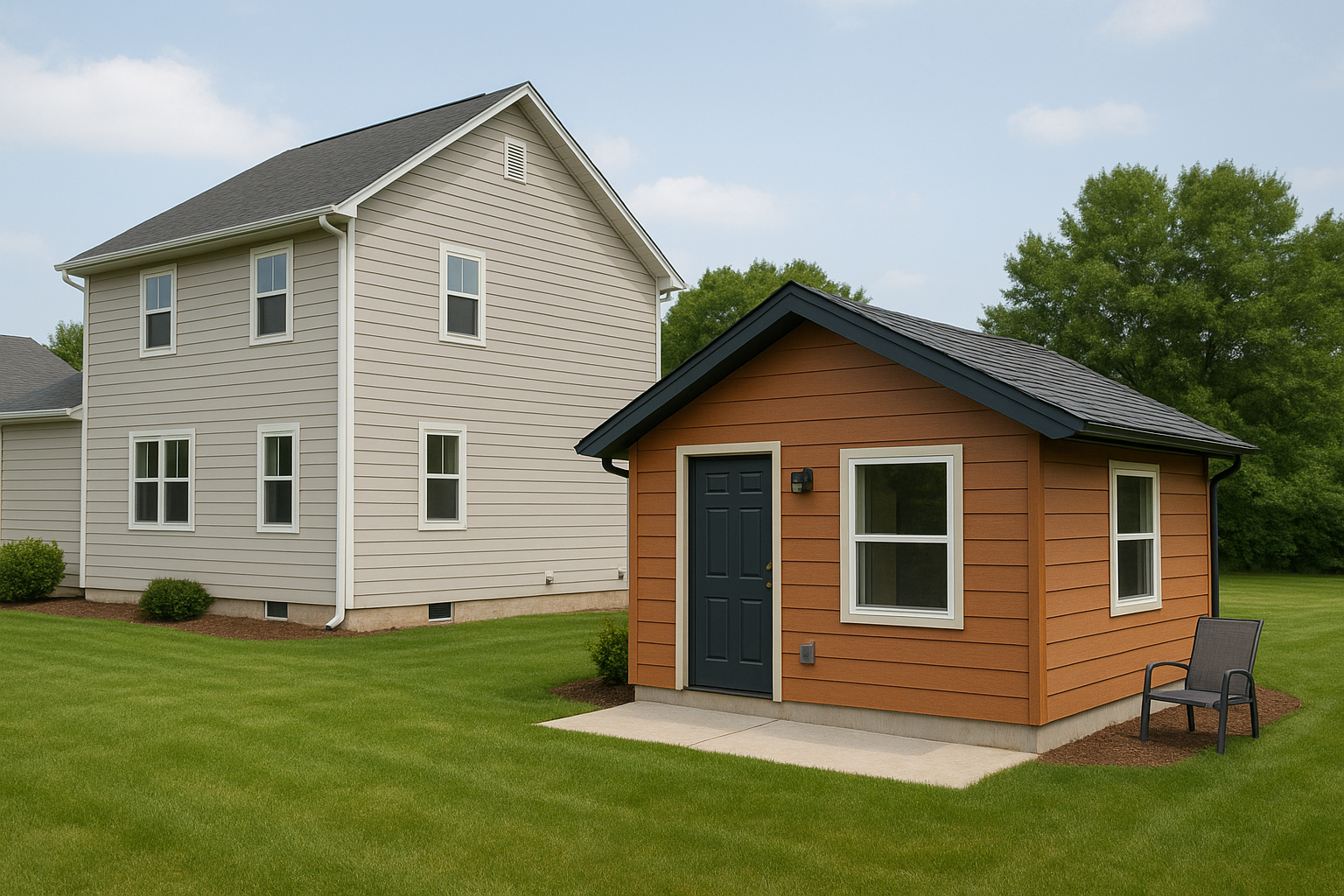This guide is for Auckland homeowners and property investors who want to understand the new 2026 rules for building a minor dwelling — and how to use them to generate income, support family, or add long-term value to their property.
1. What Is a Minor Dwelling?
A minor dwelling — often called a granny flat or second unit — is a fully self-contained home built on the same site as an existing house. It includes a kitchen, bathroom, bedroom and living area, with its own outdoor space like a deck or patio.
From 2026, these units can be up to 70 m², making them ideal for:
🔹Investors wanting to add a rental income stream
🔹Homeowners looking to support extended family or generate passive income
🔹Retirees wanting to downsize on their own section
Each property can have one minor dwelling, and it must be built to the Building Code with appropriate service connections.
From 2026, these units can be up to 70 m², making them ideal for:
🔹Investors wanting to add a rental income stream
🔹Homeowners looking to support extended family or generate passive income
🔹Retirees wanting to downsize on their own section
Each property can have one minor dwelling, and it must be built to the Building Code with appropriate service connections.
2. What’s Changing in 2026?
From 2026, building a minor dwelling becomes much easier thanks to new nationwide legislation. You’ll no longer need building or resource consent — as long as you follow a few clear rules.
Summary of Changes:
🔹No building consent required (if under 70 m² and code-compliant)
🔹No resource consent needed in most residential and rural zones
🔹No long delays waiting for approvals
🔹Lower upfront costs
Key Conditions:
🔹Unit must be no more than 70 m²
🔹Must follow the Building Code
🔹Built or supervised by licensed professionals
🔹Must notify the council before and after construction
This new path reduces red tape and allows homeowners and investors to act faster and save thousands in approval-related fees and holding costs.
Summary of Changes:
🔹No building consent required (if under 70 m² and code-compliant)
🔹No resource consent needed in most residential and rural zones
🔹No long delays waiting for approvals
🔹Lower upfront costs
Key Conditions:
🔹Unit must be no more than 70 m²
🔹Must follow the Building Code
🔹Built or supervised by licensed professionals
🔹Must notify the council before and after construction
This new path reduces red tape and allows homeowners and investors to act faster and save thousands in approval-related fees and holding costs.
3. What Still Needs to Be Done
Even without consent, some responsibilities remain:
🔹You must use licensed builders, plumbers and electricians
🔹The unit must be safe and code-compliant
🔹You still notify the council before starting and once finished
🔹You must connect to water, wastewater and electricity
🔹Infrastructure and service charges (e.g. Watercare) still apply
Stormwater will also need to be managed onsite with a soak pit, detention tank or suitable drainage system, depending on your section.
🔹You must use licensed builders, plumbers and electricians
🔹The unit must be safe and code-compliant
🔹You still notify the council before starting and once finished
🔹You must connect to water, wastewater and electricity
🔹Infrastructure and service charges (e.g. Watercare) still apply
Stormwater will also need to be managed onsite with a soak pit, detention tank or suitable drainage system, depending on your section.
4. What Are the Current Rules (Until 2026)?
If you want to build a minor dwelling today, you must still:
🔹Apply for building consent
🔹In some zones, apply for resource consent
🔹Prepare full design plans
🔹Pay application and development fees
🔹Pass inspections throughout the build
This can take months and adds complexity. From 2026, those delays are eliminated for eligible minor dwellings.
🔹Apply for building consent
🔹In some zones, apply for resource consent
🔹Prepare full design plans
🔹Pay application and development fees
🔹Pass inspections throughout the build
This can take months and adds complexity. From 2026, those delays are eliminated for eligible minor dwellings.
5. Where Can You Build a Minor Dwelling in Auckland?
Minor dwellings are already allowed on many residential sections —
and the 2026 rules expand that further.
Common zones:
🔹Single House Zones – Build one minor dwelling if rules are followed
🔹Mixed Housing Zones – Often allow more than one dwelling
🔹Rural Zones – Some allow minor dwellings if over 1 hectare; new rules expand this
🔹Māori Purpose and Mixed-Use Zones – Allowed under 2026 changes
You still need to check for overlays like flood zones or heritage areas, which may require additional steps.
and the 2026 rules expand that further.
Common zones:
🔹Single House Zones – Build one minor dwelling if rules are followed
🔹Mixed Housing Zones – Often allow more than one dwelling
🔹Rural Zones – Some allow minor dwellings if over 1 hectare; new rules expand this
🔹Māori Purpose and Mixed-Use Zones – Allowed under 2026 changes
You still need to check for overlays like flood zones or heritage areas, which may require additional steps.
6. What Does It Cost?
While red tape is easing, construction and connection costs remain.
Key costs:
🔹Design and drafting fees
🔹Licensed builder charges
🔹Watercare and council infrastructure fees
🔹Labour, materials, and compliance
🔹Plumbing, electrical, and drainage works
Typical Budget Range:
Expect to invest $180,000 to $260,000 depending on site conditions and finish level.
Expected Rental Income:
Minor dwellings in Auckland commonly rent for $450 to $650 per week depending on area and quality — offering gross yields of 10–15% on build costs alone.
Key costs:
🔹Design and drafting fees
🔹Licensed builder charges
🔹Watercare and council infrastructure fees
🔹Labour, materials, and compliance
🔹Plumbing, electrical, and drainage works
Typical Budget Range:
Expect to invest $180,000 to $260,000 depending on site conditions and finish level.
Expected Rental Income:
Minor dwellings in Auckland commonly rent for $450 to $650 per week depending on area and quality — offering gross yields of 10–15% on build costs alone.
7. How to Connect to Water, Sewer and Power
You must still connect your unit to all major services:
🔹Water – Share your current meter or apply to Watercare for a separate one
🔹Wastewater – Must connect via a licensed drainlayer; old pipes may need upgrades
🔹Stormwater – Must be managed via soak pit, detention tank or council-approved outlet
🔹Electricity – Connect to your main board or install a dedicated meter
🔹Phone, gas, internet – Optional but common for rental dwellings
All connections must comply with council and Watercare rules. This is still a formal building process — just without consent paperwork.
🔹Water – Share your current meter or apply to Watercare for a separate one
🔹Wastewater – Must connect via a licensed drainlayer; old pipes may need upgrades
🔹Stormwater – Must be managed via soak pit, detention tank or council-approved outlet
🔹Electricity – Connect to your main board or install a dedicated meter
🔹Phone, gas, internet – Optional but common for rental dwellings
All connections must comply with council and Watercare rules. This is still a formal building process — just without consent paperwork.
8. Can You Rent It Out?
Yes — you can rent out a minor dwelling legally, even if it’s on the same title as your main home. You don’t need to live in one or house family — tenants are fully permitted.
This makes it ideal for:
🔹Property investors looking to increase yield
🔹Homeowners wanting rental income to reduce mortgage costs
🔹Retirees or empty nesters seeking extra cashflow
Rental Requirements:
🔹Must meet Healthy Homes Standards
🔹Requires a written tenancy agreement under the Residential Tenancies Act
🔹Must provide privacy and safe access
Separate meters for water or power are not mandatory but help with tenant fairness and are often preferred.
This makes it ideal for:
🔹Property investors looking to increase yield
🔹Homeowners wanting rental income to reduce mortgage costs
🔹Retirees or empty nesters seeking extra cashflow
Rental Requirements:
🔹Must meet Healthy Homes Standards
🔹Requires a written tenancy agreement under the Residential Tenancies Act
🔹Must provide privacy and safe access
Separate meters for water or power are not mandatory but help with tenant fairness and are often preferred.
9. Step-by-Step Summary: Building in 2026
Here’s how the process will look:
✔️Check your zoning using Auckland Council’s online maps
✔️Confirm the site is not in a flood zone or protected area
✔️Engage a licensed builder or designer for a simple, code-compliant plan
✔️Keep the build under 70 m² and follow all new rules
✔️Notify the council before starting
✔️Use qualified trades for all work
✔️Connect water, wastewater, stormwater and power
✔️Notify council when the build is finished
✔️Pay all required infrastructure or service fees
✔️Rent it out or enjoy it as a family solution
✔️Check your zoning using Auckland Council’s online maps
✔️Confirm the site is not in a flood zone or protected area
✔️Engage a licensed builder or designer for a simple, code-compliant plan
✔️Keep the build under 70 m² and follow all new rules
✔️Notify the council before starting
✔️Use qualified trades for all work
✔️Connect water, wastewater, stormwater and power
✔️Notify council when the build is finished
✔️Pay all required infrastructure or service fees
✔️Rent it out or enjoy it as a family solution
10. Why It’s a Smart Move for Investors and Homeowners
Whether you’re building for family or profit, minor dwellings are a high-impact,
low-risk property move.
Benefits for Property Investors:
🔹Add a rental stream without subdividing
🔹Gross yields of 10–15% achievable in many areas
🔹Increase equity by improving site value
🔹Reduce risk with lower upfront approvals and faster build time
Benefits for Homeowners:
🔹Create independent living for extended family
🔹Use rental income to support mortgage repayments
🔹Boost property value without full redevelopment
🔹Improve land use without needing to sell or subdivide
low-risk property move.
Benefits for Property Investors:
🔹Add a rental stream without subdividing
🔹Gross yields of 10–15% achievable in many areas
🔹Increase equity by improving site value
🔹Reduce risk with lower upfront approvals and faster build time
Benefits for Homeowners:
🔹Create independent living for extended family
🔹Use rental income to support mortgage repayments
🔹Boost property value without full redevelopment
🔹Improve land use without needing to sell or subdivide
Renting Tips and Income Considerations
If you’re planning to rent your minor dwelling, here are a few tips:
🔹Install separate meters for power and water if possible
🔹Provide dedicated access and private outdoor space
🔹Let neighbours know your plans to maintain good relationships
🔹Keep up with maintenance to protect your long-term investment
Tax and Deductions:
🔹Rental income must be declared to Inland Revenue
🔹You can claim deductions for repairs, maintenance, rates, and interest (if borrowed to build)
🔹Keep accurate records from day one
🔹Install separate meters for power and water if possible
🔹Provide dedicated access and private outdoor space
🔹Let neighbours know your plans to maintain good relationships
🔹Keep up with maintenance to protect your long-term investment
Tax and Deductions:
🔹Rental income must be declared to Inland Revenue
🔹You can claim deductions for repairs, maintenance, rates, and interest (if borrowed to build)
🔹Keep accurate records from day one
Final Thoughts
The 2026 changes open a powerful door for Auckland property owners — whether you’re an investor chasing returns, or a homeowner wanting to support your family or reduce your mortgage.
By removing the need for building consent, the process becomes faster, cheaper and far less stressful — while still requiring quality construction and professional service connections.
Now is the time to start preparing:
🔹Identify suitable sites
🔹Confirm zoning and overlays
🔹Speak to a licensed builder or designer
🔹Be ready to act when the rules come into effect
By removing the need for building consent, the process becomes faster, cheaper and far less stressful — while still requiring quality construction and professional service connections.
Now is the time to start preparing:
🔹Identify suitable sites
🔹Confirm zoning and overlays
🔹Speak to a licensed builder or designer
🔹Be ready to act when the rules come into effect
Ready to Take the Next Step?
Whether you’re a homeowner planning for family needs or a property investor looking to increase returns, building a minor dwelling is now simpler, faster, and more profitable than ever.
For expert advice, site assessments, or a fixed-price quote, contact The Renovation Team today.
📞 Phone: +64212305511
🌐 Website: www.TheRenovationTeam.co.nz
📍 Serving Auckland-wide
We’ve helped hundreds of Auckland property owners turn unused space into smart, income-generating dwellings. Let us help you do the same.
For expert advice, site assessments, or a fixed-price quote, contact The Renovation Team today.
📞 Phone: +64212305511
🌐 Website: www.TheRenovationTeam.co.nz
📍 Serving Auckland-wide
We’ve helped hundreds of Auckland property owners turn unused space into smart, income-generating dwellings. Let us help you do the same.
















